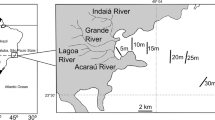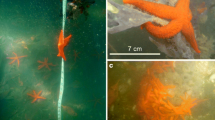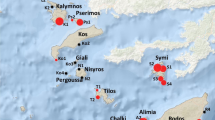Abstract
The population structure of the slate-pencil sea urchin Heterocentrotus mammillatus was studied along the southeastern coast of the Sinai peninsula. Evenly-distributed size classes were observed in populations occupying the forereef, while populations of this species from the reef slope and the back reef contained smaller proportions of small and medium-sized individuals. During the five years of study, growth rates and abundances of each size group were found to be stable. Analysis of size frequency distributions show that recruitment of H. mammillatus at the study area was regular and mortality rates were low during the second to fifth year of life and increasing later. This was supported by aging of dead individuals and observations indicating that large individuals were more susceptible to predation than smaller ones.
Similar content being viewed by others
References
Birkeland CE, Chia FS (1971) Recruitment risk, growth, age and predation in two populations of the sand-dollar Dendraster excentricus. J Exp Mar Biol Ecol 6:265–278
Crapp CB, Willis ME (1975) Age determination in the sea-urchin Paracentrotus lividus with notes on the reproductive cycle. J Exp Mar Biol Ecol 20:157–178
Dafni J, Tobol R (1986) Population structure patterns of a common echinoid (Tripneustes gratilla elatensis). Isr J Zool 34:191–204
Dotan A (1986) Aspects of the biology and ecology of sea urchins at the northern Red Sea with an emphasis on Heterocentrotus mammillatus. PhD thesis, Tel Aviv University, Israel (in Hebrew)
Dotan A (1990) The reproduction of the slate pencil sea urchin Heterocentrotus mammilatus (L.) in the northern Red Sea. Aus J Mar Freshw Res 41:457–465
Dotan A (in press) Distribution of regular sea urchins or coral reefs along the south-eastern coast of the Sinai Peninsula, Red Sea. Isr J Zool 37(1)
Dotan A, Fishelson L (1984) Morpholoy of spines of Heterocentrotus mammillatus (Echinodermata, Echinoidae) and its ecological significance. Proc Int Echinoderm Conf Galway Ireland 253–260
Ebert TA (1967) Growth and repair of spines in the sea urchin Strongylocentrotus purpuratus (Stimpson). Biol Bull 133:141–149
Ebert TA (1982) Longevity, life history and relative body wall size in sea-urchins. Ecol Monogr 52:353–394
Ebert TA (1984) The non-periodic nature of growth rings in echinoid spines. Proc Int Echinoderm Conf Galway Ireland 261–267
Estes JA, Palmisano JF (1974) Sea otters, their role in structuring nearshore communities. Science 185:1058–1060
Fishelson L (1971) Ecology and distribution of the benthic fauna in the shallow waters of the Red Sea. Mar Biol 10:113–133
Fricke HW (1974) Möglicher Einfluß von Feinden auf das Verhalten von Diadema Seeigeln. Mar Biol 27:59–62
Glynn PW (1968) Mass mortalities of echinoids and other reef flat organisms coincident with midday, low-water exposures in Puerto Rico. Mar Biol 1:226–243
Hendler G (1977) The differential effects of seasonal stress and predation on the stability of reef flat echinoid populations. Proc 3rd Int Coral Reef Symp 1:217–223
Klinker J, Kropach C, Harpaz H, Levanon I, Reiss Z (1975) DCPE-Data collecting program in the Gulf of Elat. Report 1. In: 4th Report of the Heinz Steinitz Marine Biology Laboratory, pp 46–54
Klinker J, Reiss Z, Kropach K, Levanon I, Harpaz H, Shapiro Y (1978) Nutrients and biomass distribution in the Gulf of Aqaba (Elat), Red-Sea. Mar Biol 45:53–64
Lawrence JM, Sammarco PW (1982) Effects of feeding on the environment. Echinoida. In: Jangoux M, JM Lawrence (eds) Echinoderm nutrition. Balkema, Rotterdam, pp 499–520
Levitan DR, Genovese SJ (1989) Substratum-dependent predator-prey dynamics: patch reef as refuge from gastropod predation. J Exp Mar Biol Ecol 130:111–118
Lessios HA, Robertson DR, Cubit JD (1984) Spread of Diadema mass mortality through the Caribbean. Science 226:335–337
Loya Y (1972) Community structure and species diversity of hermatypic corals at Eilat, Red Sea. Mar Biol 13:100–123
Macdonald PDM, Pitcher TJ (1979) Age-groups from size frequency data. A versatile and efficient method of analysing distribution mixtures. J Fish Res Bd Can 36:987–1001
Mergner H, Schuhmacher H (1974) Morphologie, Ökologie und Zonierung von Korallenriffen bei Aquaba (Golf von Aquaba, Rotes Meer). Helgol Wiss Meeresunters 26:238–258
Mortensen T (`937) Contributions to the study of the development and larval forms of echinoderms. D. Kgl Danske Vidensk Selesk 7:1
Scheibling RE, Stephenson RL (1984) Mass mortality of Strongylocentrotus droebachiensis off Nova Scotia, Canada. Mar Biol 78:153–164
Tegner MJ, Levin LA (1983) Spiny lobsters and sea-urchins. Analysis of a predator-prey interaction. J Exp Mar Biol Ecol 73:125–150
Author information
Authors and Affiliations
Rights and permissions
About this article
Cite this article
Dotan, A. Population structure of the echinoid Heterocentrotus mammillatus (L.) along the littoral zone of south-eastern Sinai. Coral Reefs 9, 75–80 (1990). https://doi.org/10.1007/BF00368802
Accepted:
Issue Date:
DOI: https://doi.org/10.1007/BF00368802




